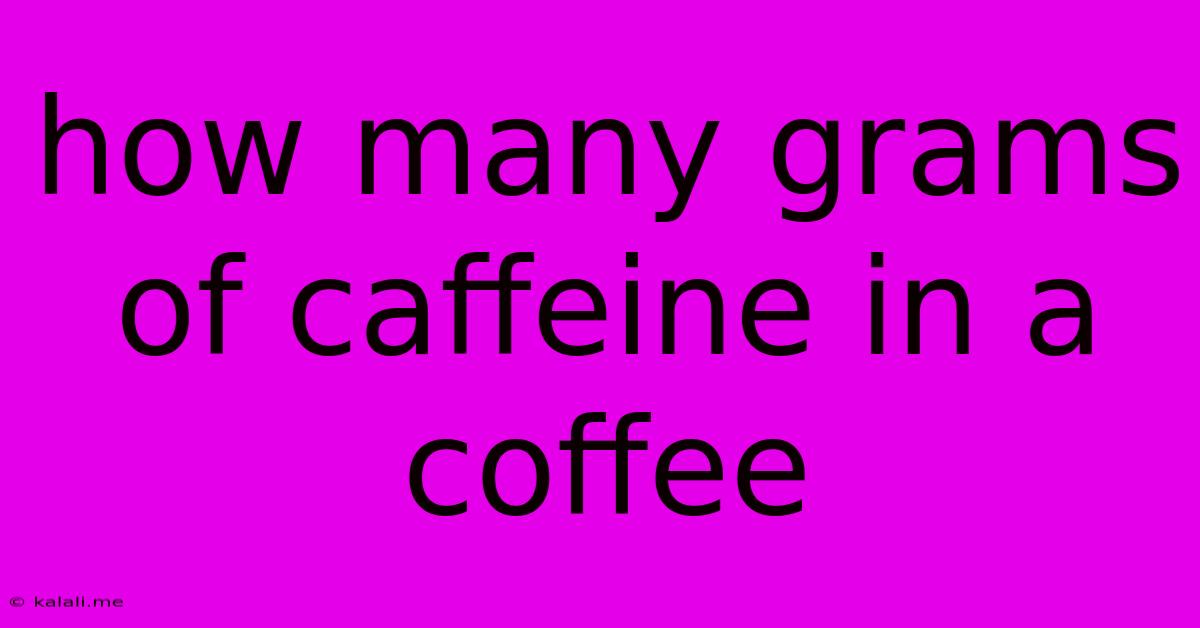How Many Grams Of Caffeine In A Coffee
Kalali
May 21, 2025 · 3 min read

Table of Contents
How Many Grams of Caffeine in a Coffee? A Comprehensive Guide
Meta Description: Wondering how much caffeine is actually in your daily cup of joe? This comprehensive guide explores caffeine content in various coffee types, brewing methods, and factors affecting caffeine levels. Learn to manage your caffeine intake effectively.
Caffeine. That magical, bitter bean extract that jumpstarts our mornings and fuels our afternoons. But how much caffeine are we actually consuming? The answer, unfortunately, isn't a simple number. The amount of caffeine in a cup of coffee varies wildly depending on several factors. This guide will break down those factors and give you a clearer picture of your caffeine consumption.
Factors Affecting Caffeine Content in Coffee
Several key factors influence the amount of caffeine in your coffee, impacting the milligrams (mg) and, ultimately, grams (g) – remembering that 1000mg = 1g.
-
Type of Coffee Bean: Arabica beans generally contain less caffeine than Robusta beans. Robusta beans can boast almost double the caffeine content of Arabica. This is a crucial factor to consider, especially for sensitive individuals.
-
Roast Level: Contrary to popular belief, the roast level doesn't significantly alter the caffeine concentration. While some minimal caffeine loss occurs during roasting, the difference is negligible compared to the variations caused by bean type and brew strength. Dark roast doesn't necessarily mean less caffeine.
-
Brewing Method: The brewing method dramatically affects caffeine extraction. Methods that use finer grinds and longer brewing times, like French press, typically extract more caffeine than methods like drip coffee or espresso. Cold brew, surprisingly, often extracts less caffeine despite longer brewing times due to the lower temperature.
-
Bean-to-Water Ratio: A stronger brew (more coffee grounds per cup of water) will naturally contain more caffeine. This is a key controllable variable when adjusting your caffeine intake.
-
Coffee Size: A larger cup of coffee will obviously contain more caffeine than a smaller one, all other factors being equal.
Caffeine Content Estimations: A Range of Possibilities
It's difficult to give a precise number for caffeine content. However, we can offer a general range based on the factors mentioned above:
- Espresso (single shot): 60-75mg caffeine
- Drip Coffee (8oz): 80-150mg caffeine
- French Press (8oz): 100-180mg caffeine
- Cold Brew (8oz): 100-150mg caffeine
- Instant Coffee (8oz): 30-90mg caffeine
Note: These are estimates. The actual caffeine content can vary significantly. To achieve gram measurements, simply divide the milligram amounts by 1000. For example, a strong French press could contain up to 0.18 grams of caffeine.
Managing Your Caffeine Intake
Knowing the factors influencing caffeine levels allows for better control. If you're sensitive to caffeine or trying to reduce your intake, consider:
- Switching to Arabica beans: Opt for lower caffeine varieties.
- Using a less aggressive brewing method: Drip coffee is generally lower in caffeine than French press.
- Reducing the bean-to-water ratio: Use less coffee for the same amount of water.
- Choosing smaller cup sizes: Opt for smaller servings to decrease your overall caffeine intake.
Understanding how many grams of caffeine are in your coffee is about more than just numbers; it’s about taking control of your daily energy levels and overall well-being. By being mindful of the factors discussed, you can enjoy your coffee while effectively managing your caffeine consumption.
Latest Posts
Latest Posts
-
What Self Defence Weapons Are Legal Uk
May 21, 2025
-
Evergreen Shrubs For East Facing Border Uk
May 21, 2025
-
Can You Bring Condoms On A Plane
May 21, 2025
-
How Often Do Males Think About Sex
May 21, 2025
-
When To Use Yours Sincerely And Yours Faithfully
May 21, 2025
Related Post
Thank you for visiting our website which covers about How Many Grams Of Caffeine In A Coffee . We hope the information provided has been useful to you. Feel free to contact us if you have any questions or need further assistance. See you next time and don't miss to bookmark.